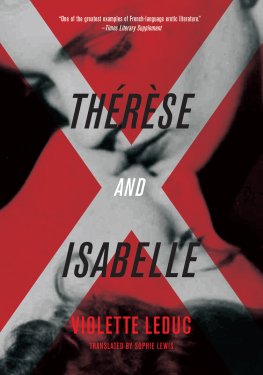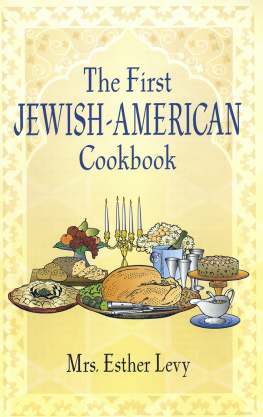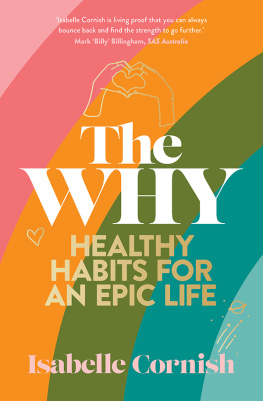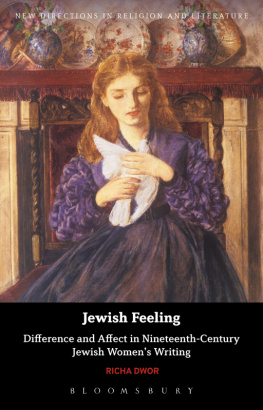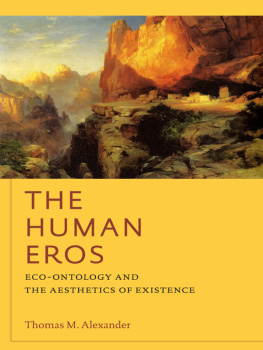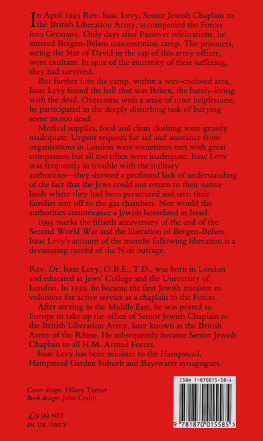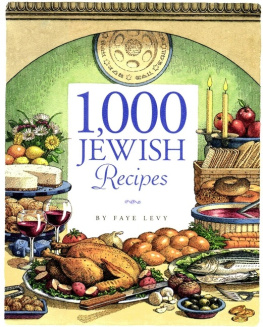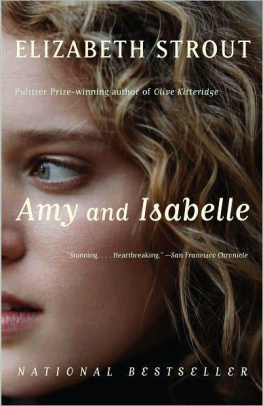Isabelle Levy - Jewish Literary Eros
Here you can read online Isabelle Levy - Jewish Literary Eros full text of the book (entire story) in english for free. Download pdf and epub, get meaning, cover and reviews about this ebook. year: 2022, publisher: IndianaUP, genre: Home and family. Description of the work, (preface) as well as reviews are available. Best literature library LitArk.com created for fans of good reading and offers a wide selection of genres:
Romance novel
Science fiction
Adventure
Detective
Science
History
Home and family
Prose
Art
Politics
Computer
Non-fiction
Religion
Business
Children
Humor
Choose a favorite category and find really read worthwhile books. Enjoy immersion in the world of imagination, feel the emotions of the characters or learn something new for yourself, make an fascinating discovery.
- Book:Jewish Literary Eros
- Author:
- Publisher:IndianaUP
- Genre:
- Year:2022
- Rating:5 / 5
- Favourites:Add to favourites
- Your mark:
- 100
- 1
- 2
- 3
- 4
- 5
Jewish Literary Eros: summary, description and annotation
We offer to read an annotation, description, summary or preface (depends on what the author of the book "Jewish Literary Eros" wrote himself). If you haven't found the necessary information about the book — write in the comments, we will try to find it.
Jewish Literary Eros — read online for free the complete book (whole text) full work
Below is the text of the book, divided by pages. System saving the place of the last page read, allows you to conveniently read the book "Jewish Literary Eros" online for free, without having to search again every time where you left off. Put a bookmark, and you can go to the page where you finished reading at any time.
Font size:
Interval:
Bookmark:

JEWISH LITERARY EROS
SEPHARDI AND MIZRAHI STUDIES
Harvey E. Goldberg and Matthias Lehmann, editors
JEWISH LITERARY
EROS
Between Poetry and Prose in the
Medieval Mediterranean
Isabelle Levy
INDIANA UNIVERSITY PRESS
This book is a publication of
Indiana University Press
Office of Scholarly Publishing
Herman B Wells Library 350
1320 East 10th Street
Bloomington, Indiana 47405 USA
iupress.org
2022 by Isabelle Levy
All rights reserved
No part of this book may be reproduced or utilized in any form or by any means, electronic or mechanical, including photocopying and recording, or by any information storage and retrieval system, without permission in writing from the publisher. The paper used in this publication meets the minimum requirements of the American National Standard for Information SciencesPermanence of Paper for Printed Library Materials, ANSI Z39.48-1992.
Manufactured in the United States of America
First printing 2022
Cataloging is available from the Library of Congress.
ISBN 978-0-253-06015-0 (hardcover)
ISBN 978-0-253-06016-7 (ebook)
Cover art: Roman de la Rose, by Guillaume de Lorris and Jean de Meung, Fourteenth century, Plimpton MS 284 f 4v, Rare Book & Manuscript Library, Columbia University Libraries.
CONTENTS
J EWISH L ITERARY E ROS IS A BOOK ABOUT A theme, a form, and a culture. The theme is, of course, loveor rather, writing about love. The form is a mixed one, combining poetry and prose, known as prosimetrum. The culture is medieval Jewish literature; this is not a simple phenomenon, for it was thoroughly interpenetrated by the non-Jewish cultures within which it flourished. Accordingly, the book deals extensively with two non-Jewish literary cultures: Arabic, which by the twelfth centurythe books starting pointhad long exerted a strong influence on Hebrew literature; and Romance literature (in Italian, French, Occitan, and Spanish), which was coming into being concurrently with the Hebrew literary works that are the books focus.
This study of the relationship between love and poetry in medieval Jewish prosimetra from the twelfth century on provides insights into attitudes toward poetry and fiction, as well as toward such varied subjects as ethics, autobiography, allegory, courting rituals, promiscuity, interreligious personal relationships, cross-dressing, and even blasphemy. By studying the literary forms and the varieties of love depicted in these works, we learn much more about social conditions and cultural values than might be expected from works that at first seem intended as pure entertainment.
This book is the first monographic study of medieval Jewish literature that weaves together all three cultural strandsHebrew, Arabic, and Romanceon a basis of equality and kinship, treating Hebrew literature not merely as a product of the impact of a foreign literature on Jewish culture but as part of the same phenomenon that produced the non-Jewish literatures themselves. This is possible because the Jewish writings treated here, dating from the twelfth century and later, arose in a world in which a new literature was being born: the erotic writing in the vernaculars descended from Latin. This situation was quite different from the medieval Hebrew golden age, which emerged in Islamic Spain, where Arabic literature had long been well established, providing a model for imitation and adaptation.
Until now, the focus of most scholarship and literary history of medieval Jewry has been the Hebrew golden age, the period from the mid-tenth to the mid-twelfth centuries in which Jewish writers of Muslim Spain produced a great outpouring of superb Hebrew poetry consciously grounded in Arabic literary traditions. The Hebrew golden age has stood at the center of scholarly attention since the beginning of the academic study of medieval Jewish literature in the early nineteenth century; its poets set a literary standard that could not be matched by poets of the thirteenth century and later.
Of course, we have long been aware that after the golden age, when Hebrew poetry lapsed into epigonism, literary prose, especially rhymed prose, became the more prominent form. But we followed the medievals in thinking of these works simply as prose, giving no weight to the poetry that they invariably include; nor did we consider the particular literary style that emerges from combining the two forms. We missed the whole point of prosimetric composition.
Furthermore, the prose literature produced in the cultural sphere of later medieval Spain, including Provence and Italy, was generally studied in light of medieval Arabic literary prose. Here and there, scholars pointed tentatively to elements in medieval Hebrew literary prose that might be explained by Romance models. But though most students of medieval Hebrew literature had intensive training in Arabic, and though most had some knowledge of Romance literature, hardly any were trained as scholars of Romance philology.
Coming to medieval Hebrew prose from just this perspective, Isabelle Levy takes an entirely new approach to the subject. Hebrew erotic narrative now appears not as a secondary phenomenon in a world that, for the most part, valued poetry more than prose but as a mainstream phenomenon as to subject matter and literary form.
This brings us to the prosimetrum, a new concept in medieval Hebrew literary studies. Since literary texts of the kind studied here have, like the poetry, been evaluated against the background of Arabic literature, their outstanding formal feature has appeared to be their being written in rhymed prose. Accordingly, they have been seen as a continuation of the rhymed prose narrative type called the maqama, which was consciously adopted from Arabic by such Hebrew authors as Judah al-arizi. This judgment has not worked very well for most other writers of rhymed prose narrative. By shifting attention from the fact that medieval Hebrew narratives rhyme to the fact that medieval Hebrew narratives mix prose and verse, Levy has enabled us to place these narratives in a broader generic field, thus broadening the scope for comparative study. Within Arabic literature, her point of reference is not only the maqama, as it has been for most studies of medieval Hebrew prose narrative, but other Arabic works that can be viewed as prosimetra, such as ibn Dwds Kitb al-zahra (The Book of the Flower), al-Washshs Kitb al-muwashsh (The book of ornamentation), and ibn azms awq al- amma (The Ring of the Dove).
This shift of focus turns out to be instructive not only for the study of Hebrew but for the study of Arabic as well, for studies of these works have never engaged with the ways in which they manipulate the relationship between prose and verse. Thus, studies of The Ring of the Dove understand the verse quotations to be merely illustrations of the points made in the prose text, seen as primary; studies of The Book of Ornamentation understand the book as an anthology of verse, with the prose content being a mere framework. Levy shows us that prose and verse interact, in both works, to make a point about the nature of love and love poetry and that they are integral to each other as well as to their theme. Applying this method to the erotic stories of the Hebrew writers Solomon ibn aqbel and Jacob ben Elazar, Levy is able to elevate these works from the status of mere curiosities of Hebrew letters to works that are deeply engaged in the thematics of medieval literature in general. Further enlightenment on the use of metaphor in the context of love poetry and literary prose comes from a consideration of Jacob ben Elazars prosimetric stories in relation to such Arabic works as the
Font size:
Interval:
Bookmark:
Similar books «Jewish Literary Eros»
Look at similar books to Jewish Literary Eros. We have selected literature similar in name and meaning in the hope of providing readers with more options to find new, interesting, not yet read works.
Discussion, reviews of the book Jewish Literary Eros and just readers' own opinions. Leave your comments, write what you think about the work, its meaning or the main characters. Specify what exactly you liked and what you didn't like, and why you think so.


